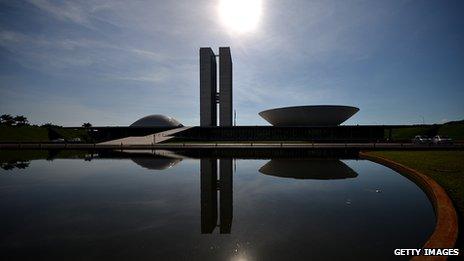Niemeyer's Brasilia: Does it work as a city?
- Published

Oscar Niemeyer the Brazilian architect who died this week will be best remembered for Brasilia, the city he helped design in the late 1950s. Niemeyer's modernist architecture made Brazil's federal capital a Unesco World Heritage site in 1987. But does it work as a city?
Brasilia was planned from scratch as an ideal city and built on an empty plateau. Niemeyer was the architect and Lucio Costa the urban planner.
The idea was, in Niemeyer's words, "to build a new capital to bring progress to the interior of Brazil".
Built in the country's heartland, Brasilia was to be the opposite of the old coastal capital Rio de Janeiro. Brasilia would be without the colonial legacy, without baroque and classical architecture, without slums.
This was a new city of clean lines, rational planning, and space. Huge amounts of it. Built to be traversed not on foot but in the motorcar.
From the air, the city was designed like an airplane - this was an era in love with air travel. The wings were where Brasilia's bureaucrats would live, the fuselage where they would work in sparkling new ministries.
"I didn't design the layout of Brasilia. I just did its architecture. And it's a place where the buildings count for a lot. The city is flat. The horizon stretches away endlessly.
"President [Juscelino] Kubitschek wanted to build a new capital. But he didn't want to build just any old capital. He wanted to build a city that would represent Brazil. So I dedicated myself to finding a new solution, something that would attract attention," said Niemeyer in an interview with the BBC in 2000.
His architecture certainly attracted attention.
By common consent his buildings for Brasilia are elegant and astonishing.
"Hauntingly beautiful" and "absolutely magical" is how the British architect Norman Foster describes some of Niemeyer's buildings in Brasilia. "A great body of work by a great architect."
"There's a wonderful optimism and beauty and light about them. They make life richer for everybody who uses them," says Lord Foster. He calls Niemeyer's presidential palace, in particular, "a gem".
But what's it like to live in Brasilia?
Brasilia - utopia or concrete carbuncle?
"The problem with Brasilia as with anything new is that it has some weaknesses," says Ricky Burdett, Professor of Urban Studies at the London School of Economics.
"The problem is that it's not a city. It's that simple. The issue is not whether it's a good city or a bad city. It's just not a city. It doesn't have the ingredients of a city: messy streets, people living above shops, and offices nearby," Burdett told the BBC World Service in 2010.
So if Brasilia is not a city then what is it?
"It just doesn't have the complexity of a normal city. It's a sort of office campus for a government," says Burdett, who was Chief Adviser on Architecture and Urbanism for the London 2012 Olympics. "People run away on Thursday evenings and go to Sao Paulo and Rio to have fun."
Modern urban planners champion mixed use neighbourhoods. In Brasilia, on the other hand, everything was to be zoned.
"It's got a place where you go to work. There are places where ambassadors have to sleep, and they are extremely unhappy about that because there isn't a street life," says Burdett.

Niemeyer's building for the two houses of the National Congress of Brazil
"It's the most extraordinary sight: when you fly over the city, you just see neon lights concentrated in one area because that is where all the shopping is."
But around Niemeyer's soaring structures and Costa's airplane plan, ordinary human life has established itself.
"All you have to do is to go out of central Brasilia and you get completely normal plazas and streets with kids playing, and places open every hour of the day and night, selling food and illegal alcohol and everything else," says Burdett.
In part the problem with Brasilia is that in some ways it succeeded too well. Designed for about 500,000 people, the city now holds over 2.5 million. The apartment building complexes that communist-sympathising Niemeyer designed to house the rich and the poor, are now home to the rich and the rich.
People living in Brasilia appreciate Niemeyer's work but the city can be tough to live in. "It's difficult as a pedestrian. It doesn't always feel like it's on a scale designed for humans," says Lucy Jordan a journalist in Brasilia.
"The poor have been shunted out to satellite cities, which range from proper well-built cities to something more like a shanty town. So the utopian ideal hasn't exactly worked out with Brasilia."
Whatever the criticisms levelled at Brasilia, Niemeyer stood by his creation.
"If you go to see Brasilia, the important thing is this: you may or may not like the buildings, but you could never say you had seen something similar before. Those fine columns, the buildings like feathers touching the ground, all that creates an effect of surprise.
"I don't take too much notice of the criticisms that people make. The project is done. Like everything else it has good points and bad points. People who criticise are either doing so out of envy or because they have nothing better to do."
Or perhaps, it is simply too soon to tell. "Most of the places that we all adore, all of them, from Cairo to London, took either 5,000 or 6,000 years to get there, or 2,000 or 3,000 years to get there," says Burdett.
Brasilia is only a little over 50 years old. "Let's not be unkind. Let's wait another 200 years and then talk about it."
Lord Foster, Lucy Jordan and Professor Ricky Burdett spoke to Newshour on the BBC World Service.